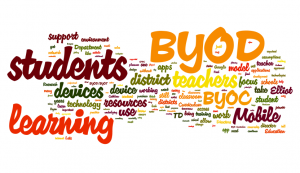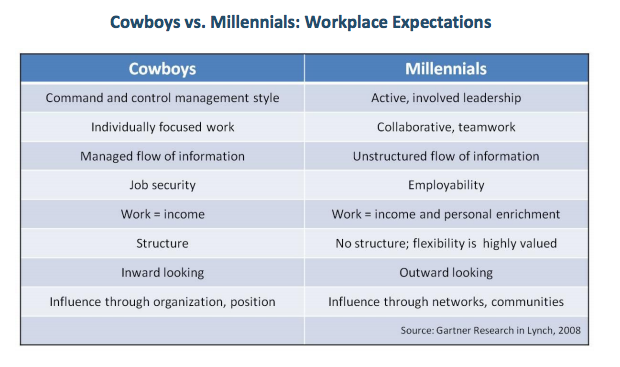 As I continue to work through the BYOC Model, and the idea that we should “flip” the roles of students and teachers in BYOD, I am still constantly trying to find research and best practice for BYOD/BYOT in an educational setting. Since the BYOC model that I propose is based upon the architecture and methods of BYOD, it has to be valid for a traditional BYOD implementation and current trends in BYOD. I like to think of BYOC as the natural evolution of BYOD to be more person centered, rather than device centered. That was a lot of words to say: Lets look at the world of BYOD.
As I continue to work through the BYOC Model, and the idea that we should “flip” the roles of students and teachers in BYOD, I am still constantly trying to find research and best practice for BYOD/BYOT in an educational setting. Since the BYOC model that I propose is based upon the architecture and methods of BYOD, it has to be valid for a traditional BYOD implementation and current trends in BYOD. I like to think of BYOC as the natural evolution of BYOD to be more person centered, rather than device centered. That was a lot of words to say: Lets look at the world of BYOD.
First, I want to share a Magazine with you: My BYOC Flipboard. If you do not know how flipboard works: this is a magazine that I curate about recent articles in BYOD and BYOT. I am curating articles from Business, Technology, and Education sectors to create a composite magazine that addresses BYOC. As I learn more about this model of placing ownership on those who are doing the acting (students or employees), I find that I continually see articles and mentions of BYOD in the context of Millennials. Before I get to far in this explanation, it is important to make sure we are all on the same page.
Vocabulary:
Lets get into the terminology here for a bit. I am an Educational Technologist, so I naturally gravitate toward acronyms that focus on education. As more businesses have been entering the arena of BYOD, they have come up with several of their own acronyms to meet this change in BYOD.
BYOD: Bring Your Own Device
The most popular term in business and IT Development. This term was first introduced to the IT World in 2004 by Ballagas, but focused on an interactive way to create display boards – for marketing. BYOD did not really enter the main stream of business until it was picked up and implemented by Intel and its Employees in 2009. In this day, BYOD is loosely translated as allowing employees to access company data from a personal device. Using that definition, you can see clear benefits to overhead cost and management, but there is a significant decrease in data security. Looking at this from a Generational perspective, there have been a lot of changes in the way that work is accomplished since BYOD started.
BYOT: Bring Your Own Technology
This “Technology” centric means of implementing BYOD is simply allowing for Technology to be more loosely defined. This also includes other terms like BYOA: Bring Your Own Access (bringing your own access point to company resources) and BYON: Bring Your Own Network (which is the ability to bring and create your own network when the one around you does not meet your needs). In schools, there has been a growing trend to go more towards the BYOT trend, but with the current legal and technology climate, we cannot afford to integrate these systems, in most cases, and must actively prevent them from happening. Now, I feel like I need to confess, I am the guy that I spend my day protecting against. I am the student who would go into school, create torrents, create private networks, and wreak havoc on the systems – and now I am helping to run them.
What is BYOC?
BYOC is an acronym that I started using to express an idea: the idea that students should be responsible for their own method of learning and be able to evaluate their own curriculum (or Bring Their/Your Own Curriculum). This idea is an education specific model for implementing BYOD but it has implications outside of Public Education and, has some interesting business implications. BYOC is the idea that as each devices allows for a connection to a wealth of resources, materials, and people, the weight of evaluating and selecting which resources to use to learn should be the responsibility of the student – not the responsibility of the teacher. It is physically impossible for a teacher, or an IT Department for that matter, to evaluate the resources available in a single app store (at last count, there were 1.2 Million Apps in the Apple App Store – and most people know that the Education section is the worst place to find Education apps). Now lets think of BYOD, where students could be using applications from PC’s, Mac’s, iOS Devices, and Android Devices (and probably the occasional Surface or Chromebook). The idea that an educator can evaluate applications from 6-10 app stores is ridiculous.
In this day, we must shift our technology instruction on skills that are not device or application specific.
In my work, I have seen a number of Microsoft Office courses being taught around the country – and around the world. I will admit that knowing how to use office is a great skill, but nurturing the skills that allow learners to learn any application is a skill that we need to focus on. As a member of my Technology Steering Committee said “Technology should be about expanding students minds, not filling them.” When we focus all of our training on a single program, students start to learn that a presentation means PowerPoint, not that a presentation is a means of digitally communicating an idea (through a variety of means). This method of instruction fills our students with information while removing their ability to think creatively.
With that in mind, how did I get to BYOC?
BYOC is a change in name, message, and focus of the BYOD craze. As the workforce continues to trend toward Millennial’s (with some estimates saying that Millennials will be 40% of the workforce by 2020), there has been an increasing number of articles written about my generation and our ability to work. One of my favorites articles came out of the UNC Business School. The best way I have found of talking about this essential difference in our work-flow (between Millennia’s and the Generations X and Y) is described in this work. Think of all of the Generation X and Y as Cowboys (their term, not mine):
The generations preceding the Millennials are sort of like cowboys, a rugged, individualistic lot. In general, these Baby Boomers and Gen Xers believe in a command-and-control management approach, value working individually, view managers as experts and look to their employers for career planning. They like clear boundaries and have a generally inward-looking perspective as compared to Millennials (Gartner Research in Lynch, 2008).
So how is that different than a Millennial? Those of use who are Millennials tend to focus our efforts on Collaboration and Connection:
Millennials are continuous learners, team players, collaborators, diverse, optimistic, achievement-oriented, socially conscious and highly educated.
That list of characteristics of Millennials is the list of characteristics that I want to see from every student who graduates from High-School. Now when these paradigms meet in the workplace and in our schools, this is what happens:
They [Millennials] have an outward-looking perspective and interact with an extensive network of communities beyond their employer, which may be interpreted by other generations as a lack of dedication or loyalty (Gartner Research in Lynch, 2008).

Now, in case the Gartner study is not enough for you to hang your hat on (pun intended), lets take a look at an article written by Rob Asghar at Forbes. Rob mentions the findings from the Jamie Gutfreund at the Intelligence Group, a research and consumer analysis agency that focuses on youth consumer trends:
Gutfreund says that Intelligence Group studies of millennials have found that:
· 64% of them say it’s a priority for them to make the world a better place.
· 72% would like to be their own boss. But if they do have to work for a boss, 79% of them would want that boss to serve more as a coach or mentor.
· 88% prefer a collaborative work-culture rather than a competitive one.
· 74% want flexible work schedules.
· And 88% want “work-life integration,” which isn’t the same as work-life balance, since work and life now blend together inextricably.
Millennials are, in essence, “venture consumers,” Gutfreund says. They’re not looking to fill a slot in a faceless company, any more than a good venture capitalist is looking to toss money at a faceless startup. They’re looking strategically at opportunities to invest in a place where they can make a difference, preferably a place that itself makes a difference.
As I examined the differences in the Generations, I could not help but think of where I currently am and what I am experiencing. In South Korea, the business and corporate culture is every stereotype of the Cowboy mentioned above. How much you are respected in your community is a direct relation to how high you are in the corporate hierarchy. In my office, I work with two Koreans directly, they are wonderful. In the office, behind closed doors, they share their opinions and interact with us all and we are better for it. When we are outside that bubble, things are different. They can be called away for days when their boss tells them to move furniture (yes, these are IT Specialists) and they remain silent at meetings when their bosses are present. The other thing that I cannot help but notice is the individual focus of their work, we do not collaborate, and most attempts to collaborate result in “If you want us to do it tell us” comments.
So I am a Millennial, a collaborator, in a structure full of Cowboys.
BYOD For Millennial’s: BYOC
In education, BYOC is about letting the students provide their own curriculum and curate their own learning. In Business, BYOC is about allowing your Millennials to bring their own connections into your workplace. So how do you do that? Here my workplace models for integrating BYOC:
- Create Distributed Project Management: Use systems that allow for workers to freely come and go while still protecting business assets (i.e. Evernote, Trello, etc.)
- Provide Network Access: Do not focus on providing any additional infrastructure than multiple device connections to an internet network.
- Focus on the Cloud: Move as many services as possible to cloud based locations to support ubiquitous access and preferably services that have a free version so that workers can take their work with them.
- Provide On-Demand Support: Use systems like Lynda.com to support the technical training needs of your company.
- Reimburse for Services: Rather than purchasing licenses of software, pay your employees back when they purchase it themselves (at least subsidize it). This will allow your workforce to use the programs and resources that they are most comfortable with and transition costs to continuous rather than up-front.
In my transition to being a Technology Director, I have always been working to change the mentality of the companies I work with to be more Millennial focused and friendly. My coming posts will outline some of the tools I use, in a Business full of Cowboys, to integrate our Millenial’s.
